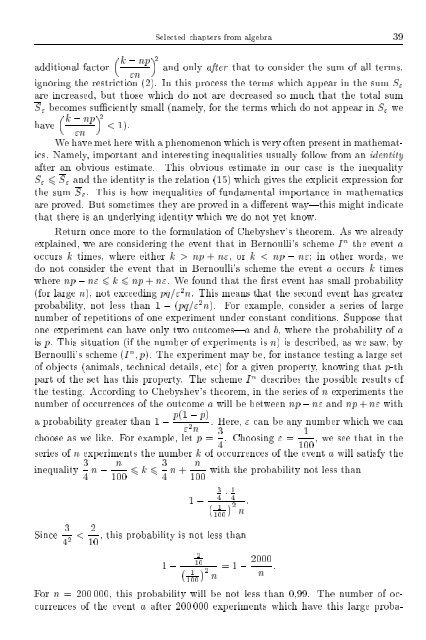SELECTED CHAPTERS FROM ALGEBRA I. R. Shafarevich Preface
SELECTED CHAPTERS FROM ALGEBRA I. R. Shafarevich Preface
SELECTED CHAPTERS FROM ALGEBRA I. R. Shafarevich Preface
Create successful ePaper yourself
Turn your PDF publications into a flip-book with our unique Google optimized e-Paper software.
Selected chapters from algebra 39 k ; np 2additional factorand only after that to consider the sum of all terms,"nignoring the restriction (2). In this process the terms which appear in the sum S "are increased, but those which do not are decreased so much that the total sumS " becomes suciently small (namely, for the terms which do not appear in S " we k ; np 2have< 1)."nWehave met here with a phenomenon whichisvery often present in mathematics.Namely, important and interesting inequalities usually follow from an identityafter an obvious estimate. This obvious estimate in our case is the inequalityS " 6 S " and the identity is the relation (15) which gives the explicit expression forthe sum S " . This is how inequalities of fundamental importance in mathematicsare proved. But sometimes they are proved in a dierent way|this might indicatethat there is an underlying identity whichwe do not yet know.Return once more to the formulation of Chebyshev's theorem. As we alreadyexplained, we are considering the event that in Bernoulli's scheme I n the event aoccurs k times, where either k > np + n", or k < np ; n" in other words, wedo not consider the event that in Bernoulli's scheme the event a occurs k timeswhere np ; n" 6 k 6 np + n". We found that the rst event has small probability(for large n), not exceeding pq=" 2 n. This means that the second event has greaterprobability, not less than 1 ; (pq=" 2 n). For example, consider a series of largenumber of repetitions of one experiment under constant conditions. Suppose thatone experiment canhave onlytwo outcomes|a and b, where the probability ofais p. This situation (if the number of experiments is n) is described, as we saw, byBernoulli's scheme (I n p). The experiment may be, for instance testing a large setof objects (animals, technical details, etc) for a given property, knowing that p-thpart of the set has this property. The scheme I n describes the possible results ofthe testing. According to Chebyshev's theorem, in the series of n experiments thenumber of occurrences of the outcome a will be between np;n" and np + n" withp(1a probability greater than 1 ; ; p). Here, " can be any number which wecan" 2 nchooseaswelike. For example, let p = 3 4 . Choosing " = 1 ,we see that in the100series of n experiments the number k of occurrences of the event a will satisfy theinequality 3 4 n ; n100 6 k 6 3 4 n + n with the probability not less than1001 ; 3 4 1 4; 1100 2n :Since 3 4 < 2 , this probability is not less than2 101 ;210; 1100 2n=1;2000n :For n = 200 000, this probability will be not less than 0,99. The number of occurrencesof the event a after 200 000 experiments which have this large proba-
















